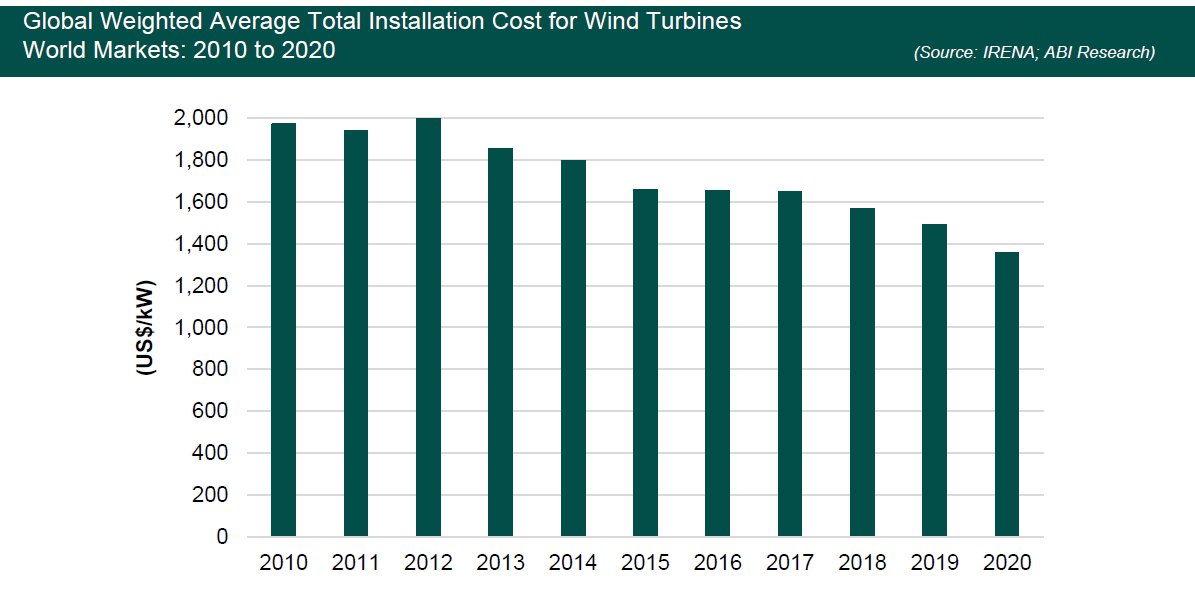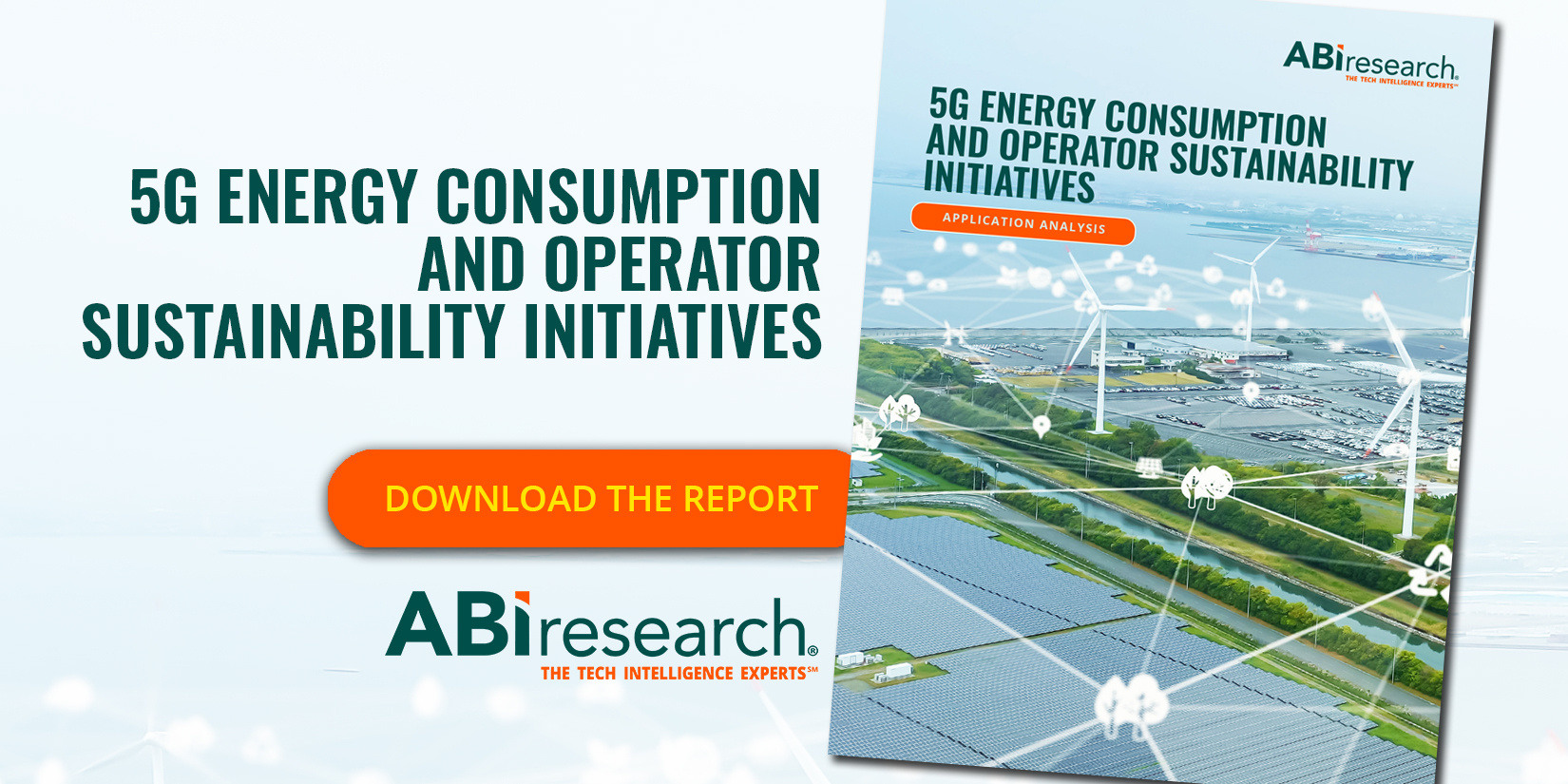With climate change being at the forefront of the public’s conscience, telecommunications operators and vendors need to look for innovative ways to conserve energy. Although 5G is 90% more energy efficient per unit of traffic than 4G, it still requires substantially more overall energy consumption—from heavy traffic load, Massive Multiple-Input Multiple-Output (mMIMO), Radio Access Networks (RANs), and cell site capacity. For example, a 5G base station needs 3X more power than a 4G base station.
ABI Research’s 5G Energy Consumption and Operator Sustainability Initiatives report looks at the best sustainable practices to carry out green initiatives as an operator or a vendor.
How to Conserve Energy Consumption When Using 5G
To reduce energy consumption from the use of 5G, telco companies must pay close attention to three key levels: the network level, the equipment level, and the site level. From promising new chipsets to renewable energy solutions, the adoption of technology is integral to achieving carbon neutrality.
Network Level
Replacing legacy radios with newer ones has proven to be a sustainable practice with great results for telco companies with green initiatives. Using Ericsson’s latest radio iteration, Vodaphone managed to reduce energy consumption, on average, by 43% during a trial in London. And during off-peak times, that number was up to 55%.
In another instance, Orange Spain relied on 50% fewer radio units once it implemented ZTE’s UniSite+, which improves the capabilities of Radio Access Technology (RAT) and bands. In addition to that, Orange Spain cut back its network power consumption by 30% and operational costs by 50%.
Artificial Intelligence (AI) and Machine Learning (ML) strike a balance between network performance and energy savings by tracking data traffic, network availability, and user experiences. Some solutions will automatically switch various network elements to sleep mode when user traffic is low, and then turn back on when traffic increases. Vendors that deploy these technologies offer energy consumption reduction of 20% or more.
Equipment Level
With roughly 60% of energy consumption stemming from the operations stage of mobile network equipment, telco companies turn to the following:
- Gallium Nitride (GaN)
- Liquide cooling
- Open RAN
- Next-generation chipsets
- New architecture
GaN
GaN is optimal for power-hungry mMIMO base stations as it can address a wide variety of frequencies. Vendors like Huawei, ZTE, and NEC are early adopters of GaN and use the semiconductor technology to address the sustainability efforts of operators. GaN can lower transmit power, improve Active Antenna Unit (AAU) efficiency, and limit the convolution of circuits.
Liquid Cooling
Deploying liquid cooling, although in its early days, is a sustainable practice that offers both cost savings and an effective way to conserve energy as a telco operator. Whereas standard air conditioners produce noise pollution and require regular maintenance, liquid cooling does not. Amazingly, liquid cooling is 4,000X better at transferring waste heat than air conditioning—providing a significant reduction in costs.
Open RAN
Open RAN allows operators to use hardware and tools from multiple vendors while keeping interoperability possible. What’s so useful about Open RAN is that it lessens the capacity burdens of cell sites.
Chipsets
The new generation of chipsets is a driving force behind telco green initiatives. New chipsets from vendors like ZTE, Ericsson, and Nokia offer energy savings between 30% and 70%. Although the semiconductor shortage is a factor, competition will grow, with new players Xilinx, Marvell, and Qualcomm entering the market.
Architecture
As sustainability efforts become mainstream for telcos, vendors are putting energy savings at the heart of architecture for materials and design. As an example, Huawei’s newest MetaAAU fuses hardware and software to improve 5G performance, while conserving a significant amount of energy. With MetaAAU, the User Experience (UX) can increase by as much as 60%, extend coverage by 30%, and reduced energy consumption levels by 30%. Another development comes from ZTE in the form of its V-tooth heat dissipation, which lowers the temperature of the main components of the system.
Site Level
Operators are replacing traditional energy sources with renewable alternatives in order to accommodate their sustainability goals. Although an initially expensive investment, ammonia-based generators can save operators between 20% and 50% per Kilowatt Hour (kWh).
Costs associated with solar power installation, as well as Operations and Maintenance (O&M), have dramatically decreased since 2010, making electricity costs 85% less expensive for operators. ABI Research finds that solar power is a little bit cheaper than grid power.
Just like solar power, wind power has seen a significant reduction in costs due to economies of scale, technology maturity, and increased competition. With renewable energy being more affordable than ever, its deployment is a realistic way for telcos of all sizes to conserve energy.
The chart below depicts the decreaseing average cost of installing wind turbines.

A lithium-ion battery stores more energy than a lead-acid battery, making it ideal for telco operators looking to practice sustainability. Not only do lithium-ion batteries store more energy, but they also have twice the lifespan as lead-acid batteries, require fewer charges, take up less space, and have a round-trip efficiency of 90% to 95%.
Future of 5G Energy Optimization
5G offers impressive gains over legacy networks, but it also comes with higher power dependencies. Telcos that optimize for 5G energy on the network, equipment, and site levels can address economical and operational concerns.
So far, technological evolution in various aspects of telco operations, such as chipsets, radios, renewable energies, and more has cemented itself as the answer to sustainable practices in the 21st century. Vendors will continue to meet the demand for green initiatives by iterating upon similar products and services that reduce energy consumption even further.
As in any industry, the early adopters will continue to be large operators with the financial capital and social spotlight shining on them. Nevertheless, the costs for most eco-friendly technologies have decreased in recent years—and are within arm’s reach of small to medium-sized operators.
ABI Research’s5G Energy Consumption and Operator Sustainability Initiatives report (AN-5500) takes a deep dive into how operators and vendors are addressing the call to address climate change concerns. This report is part of the company’s 5G & Mobile Network Infrastructure research service, which includes research, data, and analyst insights.





